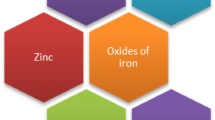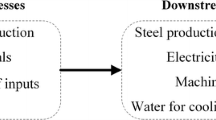Abstract
To demonstrate part of a decision-making methodology, this article evaluates steel and aluminum along traditional monetary and nontraditional environmental/health cost dimensions for the lifetime of a unibody body-in-white (B-I-W). This life is divided into four stages: the mining and refining of the raw material, the manufacture and assembly of the structure, the use of the automobile, and the post-use disposal. In terms of the six airborne pollutants tracked, comparisons between steel and aluminum are easily made because this set of effluents can be traced through all stages of the B-I-W life for both metals. In this direct comparison, assuming reduced emissions translate into an unspecified measure of environmental/health benefits, aluminum generates certain benefits versus steel.
Similar content being viewed by others
References
H.N. Han and J.P. Clark, “Lifetime Costing of the Body-in-White: Steel vs. Aluminum,” JOM (May 1995), pp. 22–28.
U.S. Bureau of the Census, Statistical Abstract of the United States: 1994 (114th edition), Washington, D.C. (1994), p. 590.
C.R Hayward, An Outline of Metallurgical Practice Second Edition (New York: D. Van Nostrand Co., 1940), pp. 498, 520.
W.T. Lankford et al., ed., The Making, Shaping and Treating of Steel, United States Steel Corporation (Pittsburgh, PA: Herbick & Held, 1985), pp. 257, 312, 346, 336.
W.C. Labys, “Trade in Materials, Intemational,” Concise Encyclopedia of Materials Economics, Policy & Management (New York: Pergamon Press, 1993), p. 396.
S. Brubaker, Trends in the World Aluminum Industry (Baltimore, MD: Johns Hopkins Press, 1967), pp. 158,87.
K. Habersatter and F. Widmer, Ecobalance of Packaging Materials State of 1990 (Berne, Switzerland: Swiss Federal Office of Environment, Forests and Landscape, February 1991), pp. A7, 33-34, A16-A17.
A. Tillman et al., Packaging and the Environment (Goteborg, Sweden: Chalmers Industriteknik, September 1991), pp. 7, 9, 162, 167-171.
H.N. Han, The Competitive Position of Alternative Automotive Materials, Ph.D. thesis, Massachusetts Institute of Technology (May 1994).
J.M. Hollander, ed., The Energy-Environment Connection (Washington, D.C.: Island Press, 1992), pp. 31, 34-36, 50-74, 229.
P.K. Maitra, “Recovery of TiO2 from Red Mud for Abatement of Pollution and for Conservation of Land and Mineral Resources,” Light Metals 1994, ed. U. Mannweiler (Warrendale, PA: TMS, 1994), p. 159.
Automobile Fuel Consumption in Actual Traffic Conditions, Organization for Economic Cooperation and Development (December 1981), p. p112.
SRI International, Potential for Improved Fuel Economy in Passenger Cars and Light Trucks, Prepared for the Motor Vehicle Manufacturers Association, Menlo Park, CA (July 1991).
M. Ross, “Automobile Fuel Consumption and Emissions: Effects of Vehicle and Driving Characteristics,” Annual Review of Energy and the Environment, 19 (1994), pp. 75–112.
C.A. Amann, “The Passenger Car and the Greenhouse Effect,” Technical Paper No. 902099 (Warrendale, PA: SAE, 1990).
Automotive Fuel Economy: How Far Should We Go?, National Research Council (Washington, D.C.: National Academy Press, 1992), pp. 72–75.
Household Vehicles Energy Consumption 1988, DOE/EIA-0464(88), Energy Information Administration, Office of Energy Markets and End Use, U.S. Department of Energy, Washington, D.C. 20585.
Motor Vehicle Manufacturers Association Motor Vehicle Facts and Figures 1991, Motor Vehicle Manufacturers Association of the United States: Detroit, MI.
R.A. Brealey and S.C. Myers, Principles of Corporate Finance (New York: McGraw-Hill, 1991), p. 13.
Federal Register (January 7, 1994).
R.J. Kopp, “Discounting for Damage Assessment,” Resources for the Future, Washington, D.C., Discussion Paper 94-31 (1994).
R.W. Hartman, “One Thousand Points of Light Seeking a Number: A Case Study of CBO′s Search for a Discount Rate Policy,” J. Environmental Economics and Management, 18 (1990), pp. S-3–S-7.
R.C. Lind, “Reassessing the Government′s Discount Rate Policy in Light of New Theory and Data in a World Economy with a High Degree of Capital Mobility,” J. Environmental Economics and Management, 18 (1990), pp. S-8–S28.
R.M. Lyon, “Federal Discount Rate Policy, the Shadow Price of Capital, and Challenges for Reforms,” J. Environmental Economics and Management, 18 (1990), pp. S-29–S-50.
R.H. Perry, D.W. Green, and J.D. Maloney, eds., Perry′s Chemical Engineers′ Handbook, 6th ed. (New York: McGrawHill Book Co., 1984), pp. 9–12.
IBIS Associates, Incorporated, Body-in-White Material Systems: A Lifecycle Cost Comparison (Final Report), Wellesley, MA (April 1992).
S.A. Mariano, F.R Tuler, and W.S. Owen, “Economic Comparison of Steel and Aluminum Automotive Structures Using Technical Cost Modeling,” Alcan Aluminum Corporation, Unpublished work.
A. Russell et al., “Urban Ozone Control and Atmospheric Reactivity of Organic Gases,” Science, 269 (July 28, 1995), pp. 491–495.
M.P. Walsh, “Environmental Challenges Posed by Growing Automobile Use,” Toward Clean and Fuel Efficient Automobiles (Paris: Organization for Economic Co-operation and Development, 1991), p. 53.
B. Hileman, “Web of Interactions Makes it Difficult to Untangle Global Warming Data,” Chemical & Engineering News, 70 (17) (1992), pp. 7–19.
R.A. Kerr, “Studies Say—Tentatively—That Greenhouse Warming Is Here,” Science, 268 (June 16, 1995), pp. 1567–1568.
X. Feng and S. Epstein, “Climatic Implications of an 8OOO-Year Hydrogen Isotope Tune Series from Bristlecone Pine Trees,” Science, 265 (August 19, 1994), pp. 1079–1081.
K. Leutwyler, “No Global Warming?,” Scientific American (February 1994), p. 24.
C.S. Powell, “Cold Confusion,” Scientific American (March 1994), pp. 22–28.
E. Friis-Christensen and K. Lassen, “Length of the Solar Cycle: An Indicator of Solar Activity Closely Associated with Climate,” Science (November 1, 1991), pp. 698–700.
R.A. Kerr, “A Fickle Sun Could Be Altering Earth′s Climate After All,” Science 269 (August, 4, 1995), p. 633.
E. Culotta, “Will Plants Profit From High CO2?,” Science 268 (May 5, 1995), pp. 654–656.
S. Allen, “Predicting Oimate,” The Boston Globe (March 2, 1994), p. 28.
J.I. Kroschwitz, ed., Kirk-Othmer Encyclopedia of Chemical Technology Fourth Edition, Volume 1 (New York: John Wiley & Sons, 1991), pp. 738, 718, 726.
C.A. Radin, “Denial of Acid Rain Dissolving in Japan,” The Boston Globe (April 2, 1994), pp. 1, 11.
R.J. Charlson and T.M.L. Wigley, “Sulfate Aerosol and Climatic Change,” Scientific American (February 1994), pp. 48–57.
Health Effects of Ambient Air Pollution, No. 0699, American Lung Association, New York, NY (July 1989), p. 34-40, 57,41-45,58,17-25,46-50.
R.A. Kerr, “Study Unveils Climate Cooling Caused by Pollutant Haze,” Science, 268 (May 12, 1995), p. 802.
D.E. Gardner and S.C.M. Gardner, “Toxicology of Air Pollution,” Basic Environmental Toxicology (Boca Raton, FL: CRC Press, Inc., 1994), pp. 287–319.
D. Ham, “How to Knock NOx: Removal from Power Plant Effluents,” The Nucleus, LXXI (5) (January 1993), p. 9.
J.J. MacKenzie and M.T. El-Ashry, eds., Air Pollution′s Toll on Forests and Crops (New Haven, CT: Yale University Press, 1989),p. 2.
L.W. Chang and L. Cockerham, “Toxic Metals in the Environment,” Basic Environmental Toxicology (Boca Raton, FL: CRC Press, Inc., 1994), pp. 109–132.
R.C. Emmett and R.P. Klepper, “High Density Red Mud Thickeners,” Light Metals 1991, ed. E.L. Rooy (Warrendale, PA: TMS, 1990), pp. 229–233.
C. Allaire, “Use of Red Mud for the Production of Aluminum Reduction Cell Potlining Refractories,” Light Metals 1992, ed. E.R. Cutshall (Warrendale, PA: TMS, 1991), pp. 401–406.
L. Piga, F. Pochetti, and L. Stoppa, “Recovering Metals from Red Mud Generated during Alumina ProductioIl,” JOM (November 1993), pp. 54–59.
J.I. Kroschwitz, ed., Kirk-Othmer Encyclopedia of Chemical Technology Fourth Edition, vol. 2 (New York: John Wiley & Sons, 1991), p. 212.
J.H. Goldman, “Regulatory Impediments to the Use of the Beneficial Values of Spent Potliner from Aluminum Reduction Facilities,” Light Metals 1991, ed. E.L. Rooy (Warrendale, PA: TMS, 1990), pp. 521–526.
D.G. Brook et al., “Thermal Treatment of Spent Potliner in a Rotary Kiln,” Light Metals 1992, ed. E.R. Cutshall (Warrendale, PA: TMS, 1991), pp. 283–287.
Author information
Authors and Affiliations
Rights and permissions
About this article
Cite this article
Han, H.N. The environmental impact of steel and aluminum body-in-whites. JOM 48, 33–38 (1996). https://doi.org/10.1007/BF03221379
Issue Date:
DOI: https://doi.org/10.1007/BF03221379




